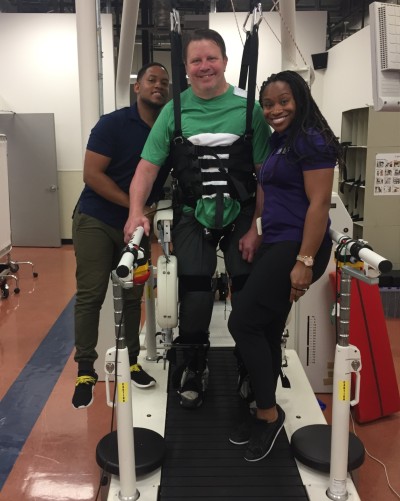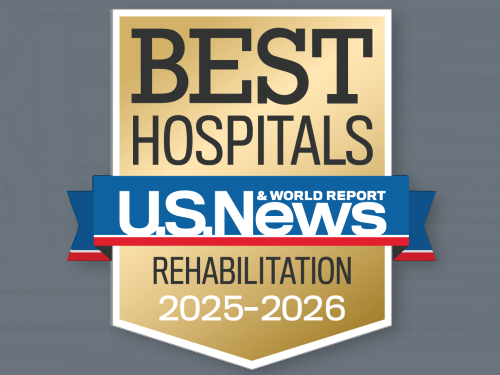 In May 2016, Mark Neagli fell down the stairs at his home, resulting in a C2 spinal cord injury, one of the most severe types of injuries. During his initial hospitalization following the fall, he was unable to move his arms and legs and was dependent on a ventilator for breathing. Today, Mark is the executive director of a foundation he helped to form, participates in clinical research projects and is enjoying life with his five children and 11 (soon to be 12) grandchildren. He credits the Spinal Cord Rehabilitation Program at TIRR Memorial Hermann with getting him back to the people and activities that mean the most to him.
In May 2016, Mark Neagli fell down the stairs at his home, resulting in a C2 spinal cord injury, one of the most severe types of injuries. During his initial hospitalization following the fall, he was unable to move his arms and legs and was dependent on a ventilator for breathing. Today, Mark is the executive director of a foundation he helped to form, participates in clinical research projects and is enjoying life with his five children and 11 (soon to be 12) grandchildren. He credits the Spinal Cord Rehabilitation Program at TIRR Memorial Hermann with getting him back to the people and activities that mean the most to him.
When he fell down the stairs, his family immediately called emergency medical services and Mark was promptly taken via Memorial Hermann Life Flight® to Memorial Hermann-Texas Medical Center, where he remained for about four weeks. Once he was medically stable, he was transferred to TIRR Memorial Hermann in the Texas Medical Center. “When he arrived at TIRR Memorial Hermann, my dad had minimal movement in his feet and hands, and he was on a ventilator,” says his daughter, Kaitlyn Padgett.
TIRR Memorial Hermann has been nationally recognized for its ventilator weaning pathway for spinal cord injury patients. This program has a success rate of over 97% in weaning patients from ventilator use prior to discharge.
Respiratory therapist Molly John, RCP, worked with Mark upon his arrival at TIRR Memorial Hermann. “We began by giving him breathing treatments to help loosen secretions and expand his lungs,” says Molly. “However, what I enjoyed most was just chatting with Mark and his family. When he left TIRR Memorial Hermann, he was weaned from the ventilator, meaning he no longer relied on mechanical support to breathe. I was so proud of him.”
 The TIRR Memorial Hermann team of caregivers created a customized treatment plan for Mark that involved his entire family. At the time of his accident, Mark was a divorced father of five who worked as an executive with the National Multiple Sclerosis (MS) Society. In his role he was responsible for handling fundraising, program services, financial efforts and more. His goal was to ultimately return to professional and volunteer work.
The TIRR Memorial Hermann team of caregivers created a customized treatment plan for Mark that involved his entire family. At the time of his accident, Mark was a divorced father of five who worked as an executive with the National Multiple Sclerosis (MS) Society. In his role he was responsible for handling fundraising, program services, financial efforts and more. His goal was to ultimately return to professional and volunteer work.
“Mark was not focused on if he was going to go back to work, but when and how he would be able to fulfil his roles as executive, father and grandfather,” says his physical therapist Adele Henry, PT, DPT, CPPS, CPHQ. “Because of Mark’s role working with the MS Society, he had a unique perspective as he began learning to instruct and participate in his own care. Mark learned to instruct his family on how to assist him, while making sure he was participating in the task to the greatest extent that he could. Mark and his family found a great balance working to return to the activities they enjoyed while also promoting his neurorecovery.”
Mark took ownership of his rehabilitation, and worked with his caregivers to ensure his goals were met. “I wanted a manual wheelchair, so my therapists didn’t push a power chair on me,” says Mark. “I was able to make my own decisions, and they had so much patience teaching my children to be my caregivers.”
On a daily basis, Mark participated in physical, occupational, speech and/or group therapies. “Mark’s dedication to his neurologic recovery was balanced by his desire to learn the most advanced adaptive technologies, like eye gaze technology, to ensure he would be able to reintegrate to the community as quickly as possible,” says Adele.
TIRR Memorial Hermann’s Adaptive Technology Lab provides patients like Mark the opportunity to learn to incorporate technological devices into their daily activities. Mark finished his first phase of inpatient care at TIRR Memorial Hermann in August 2016. At that point, he had trunk control so he could sit upright and was even regaining some movement in his upper arms.
In February 2017, Mark completed a second therapy phase lasting two weeks at TIRR Memorial Hermann. TIRR Memorial Hermann’s rehabilitation team often recommends phased admissions. This means that a patient may be in initial rehabilitation for a few weeks, then go home before readmission for additional inpatient rehabilitation therapy. During the time between admissions, the patient will continue to work on building strength and endurance. The period between phases also allows the patient’s mobility precautions to be lifted, so they can participate in more advanced activities when they return for the second phase.
After the two-week session, Mark was discharged from this second phase of inpatient care. At that point, he began outpatient therapy. “I went to TIRR Memorial Hermann Outpatient Rehabilitation – Kirby Glen Center as well as to TIRR Memorial Hermann Outpatient Rehabilitation – Memorial City for approximately one year,” says Mark. “I especially enjoyed the aquatic therapy. In the pool, I could walk forward and step up on a platform.”
 Mark visits the TIRR Memorial Hermann Outpatient Medical Clinic periodically to address spasticity, a condition in which muscles stiffen or tighten. He also works with Radha Korupolu, MD, attending physician in the Spinal Cord Program at TIRR Memorial Hermann.
Mark visits the TIRR Memorial Hermann Outpatient Medical Clinic periodically to address spasticity, a condition in which muscles stiffen or tighten. He also works with Radha Korupolu, MD, attending physician in the Spinal Cord Program at TIRR Memorial Hermann.
Mark serves as an advisory board member on research projects for Dr. Korupolu’s NIH-sponsored feasibility study on mindfulness-based meditation. “As a Community Advisory Board member, Mark has contributed valuable input on the study design, procedures and data collection methods,” says Dr. Korupolu. “He beta tested the study’s collection survey links to ensure people with similar injuries could complete them. He also plays an active role in troubleshooting study-related challenges, including participant recruitment and protocol adherence.”
Following his injury and rehabilitation, Mark returned to work with the National MS Society until he retired from the organization in 2018. He is appreciative that he had the opportunity to build lasting relationships with people living with MS, as well as with the organization’s volunteers and staff members.
Today, he serves as Executive Director (also a volunteer role) for the Victor Rivera Foundation, an organization that focuses on providing access to neurologic and neuro-ophthalmologic services for under-resourced individuals living with MS.
“Amazing work is done at TIRR Memorial Hermann,” says Mark. “Everyone was so kind. The little things they did, like hosting a Super Bowl party for patients or having the ability to visit the chapel for church services, made a difference in my experience.”
Kaitlyn adds, “The entire time my dad was a patient, someone from our family was at my dad’s side. Each caregiver at TIRR Memorial Hermann was patient as they taught us to take care of him. They let us ease into our new reality and I am so grateful for that.”
Learn more about the Spinal Cord Rehabilitation Program at TIRR Memorial Hermann >>

Nationally Ranked Rehabilitation
For the 36th consecutive year, TIRR Memorial Hermann is recognized as the best rehabilitation hospital in Texas and No. 2 in the nation according to U.S. News and World Report's "Best Rehabilitation Hospitals" in America.
Learn more about TIRR Memorial Hermann rankingsContact Us
If you have questions or are looking for more information, please complete the form below and we will contact you.